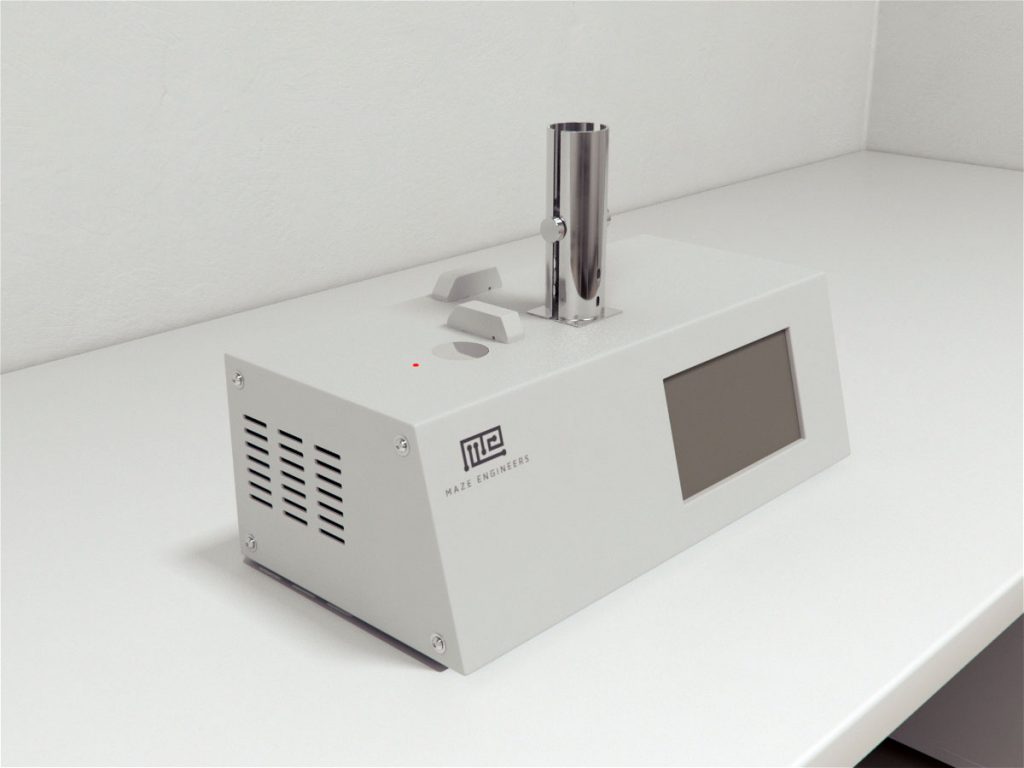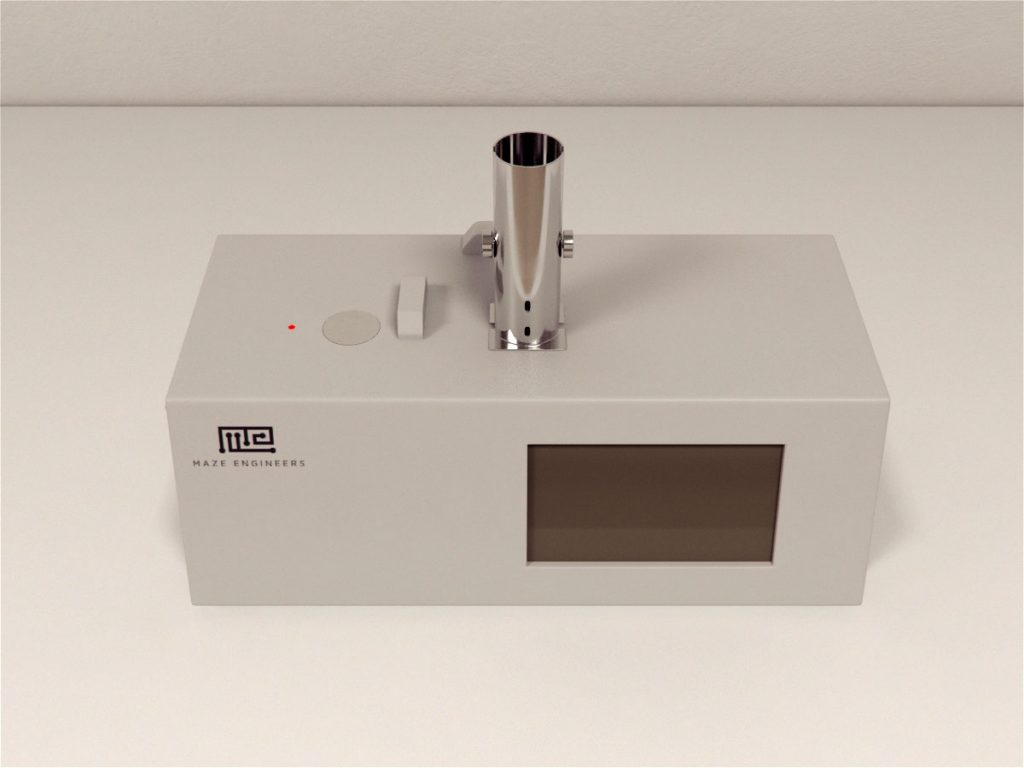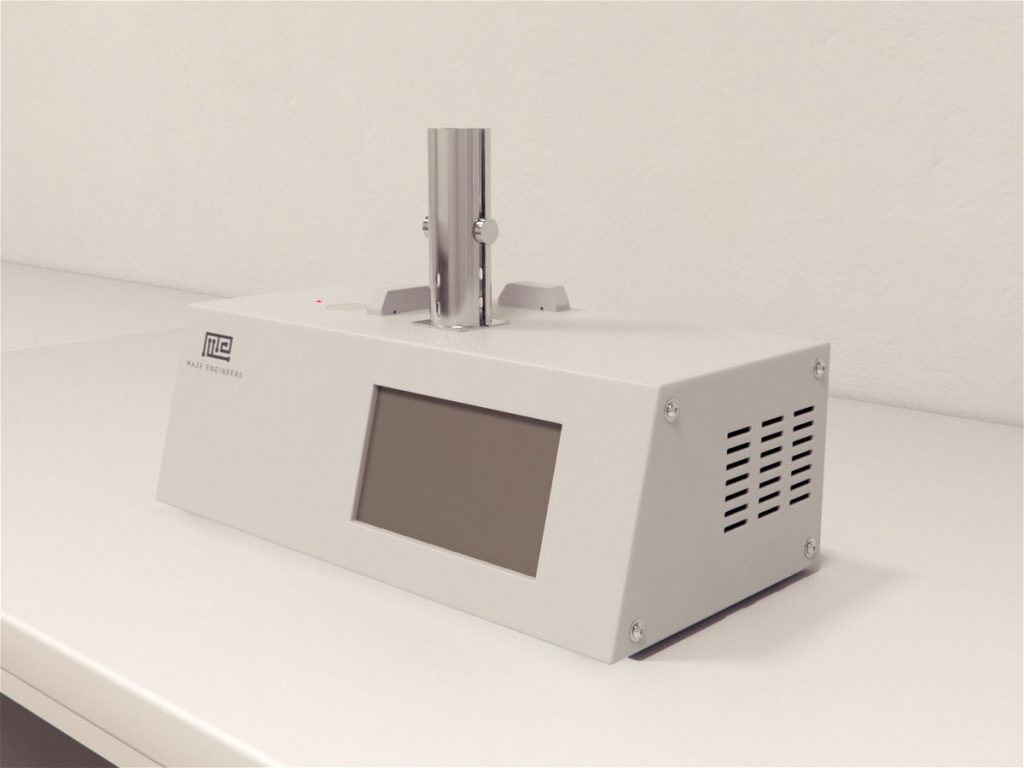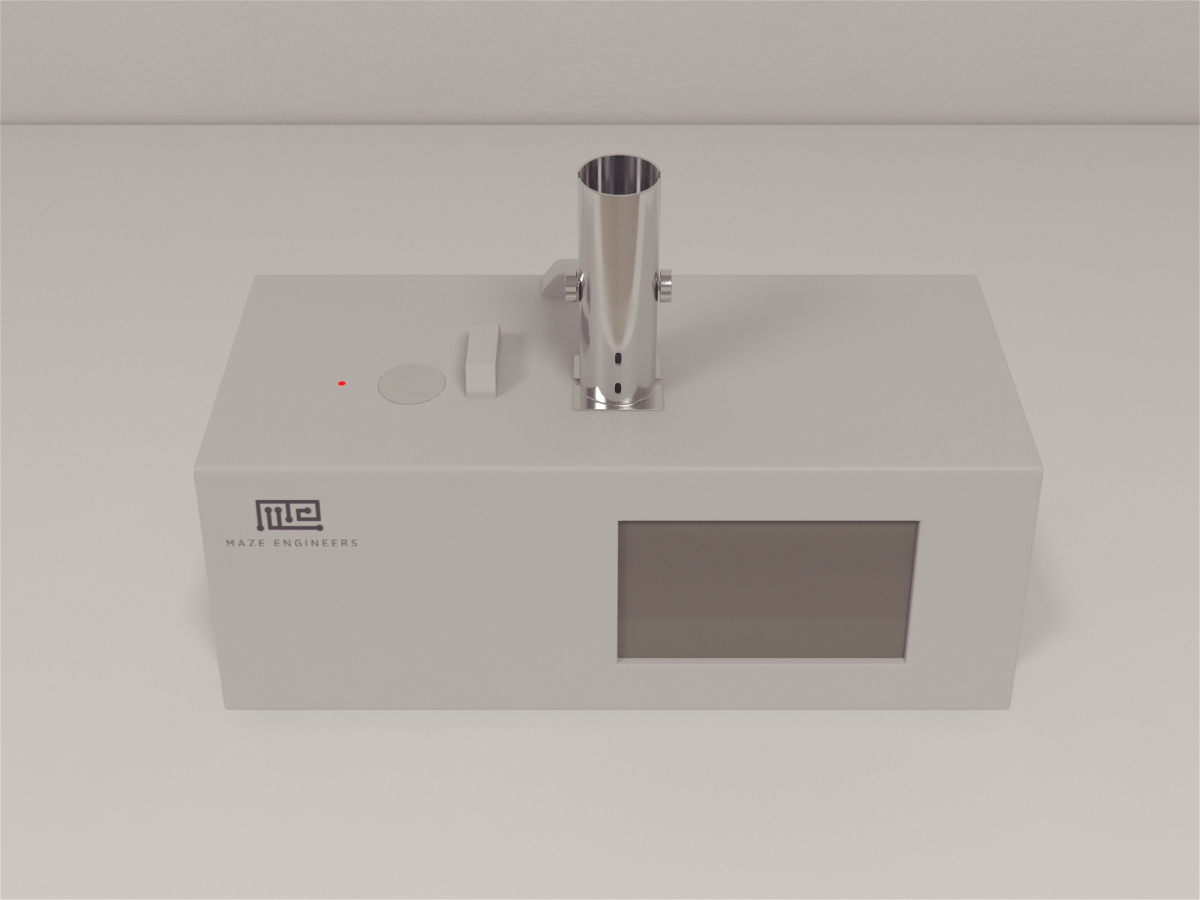
Tail Flick test was first described by D’Amour and Smith in the year 1941. In their experiment, D’Amour and Smith investigated the analgesic effects of different substances and even cobra venom on pain response of rats. The test is similar to the Hargreaves Plantar test, but instead of directing heat to the center of the rodent’s hind paw, heat stimulus is applied to the tail of the rodent. The Tail Flick test results may be dependent on the strains and species used, and their ability to acclimatize to being restrained.
The Tail Flick test has two variants; one variant uses dipping the tail into water that is maintained at a predetermined temperature, while the second variation uses the application of radiant heat stimulus to a part of the tail. For both variations, it is important that the subject is accustomed to handling. Assays similar to the Tail Flick test include the Hargreaves Plantar test, the Hot-Cold Plate test, and the Thermal Gradient test.
Features
Take advantage of Neuralynx, Ethovision Integration, SMS and Email integration with the Conductor Science Software. No I/O Boxes Required
Price & Dimensions
Tail Flick Test
$ 3990
Per MonthFor rats and mice
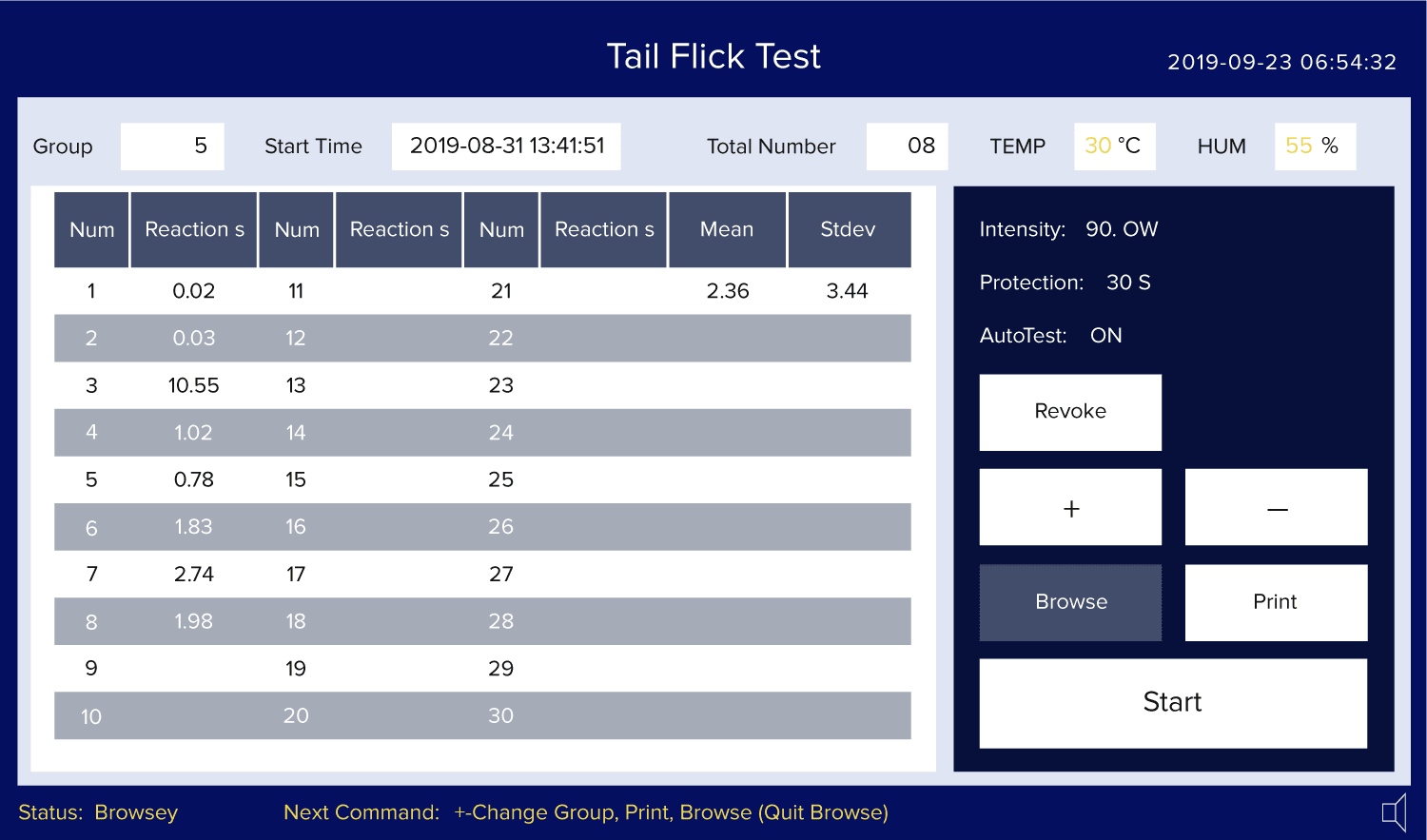
Tail Flick Data Upload Software Manual
-
Tail Flick software install
This software provides an UI application for user to upload Tail Flick test data to PC.
The software can be deployed in a folder like C:appTailFlickTest. There are two subfolders:
C:appTailFlickTestbin contains executables
C:appTailFlickTestdoc contains documentations
-
UBS to 232 Driver Install
UBS to 232 driver install on the software machine is required. The driver is included in the cable box.
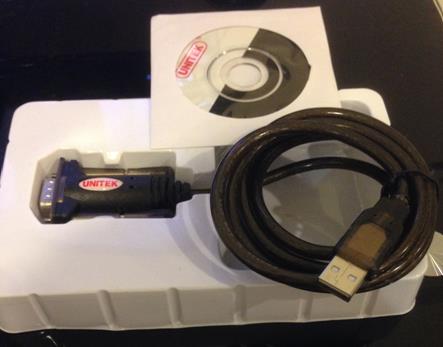
When the tail flick hardware is connected to the computer via the USB cable, a port is created as shown on the Device Manager:
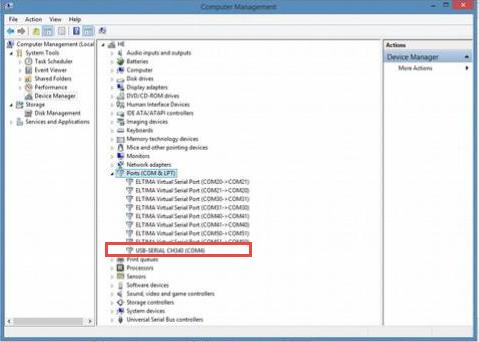
-
Start TailFlickUI
Step 1: Double click on the main application executable
C:appTailFlickTestbinTailFlickUI.exe
The application window appears as below:
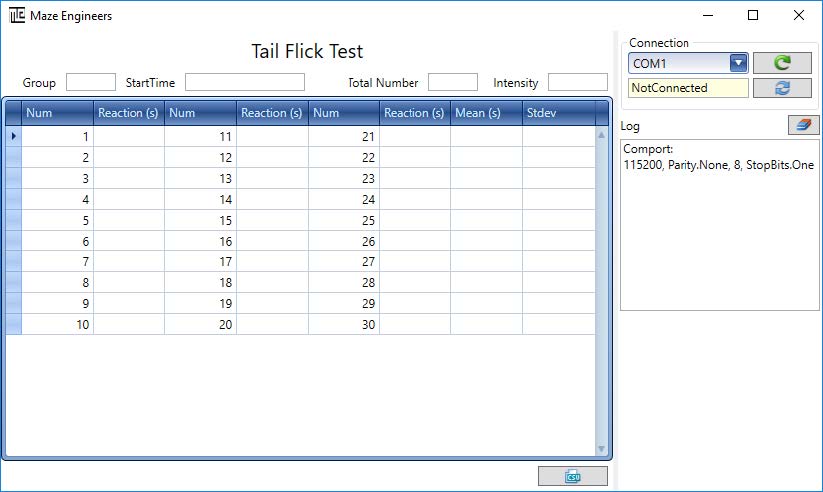
Step 2: Once the computer recognizes the hardware, choose the comport that matches the one on the Device Manager, and then click on button. ![]()
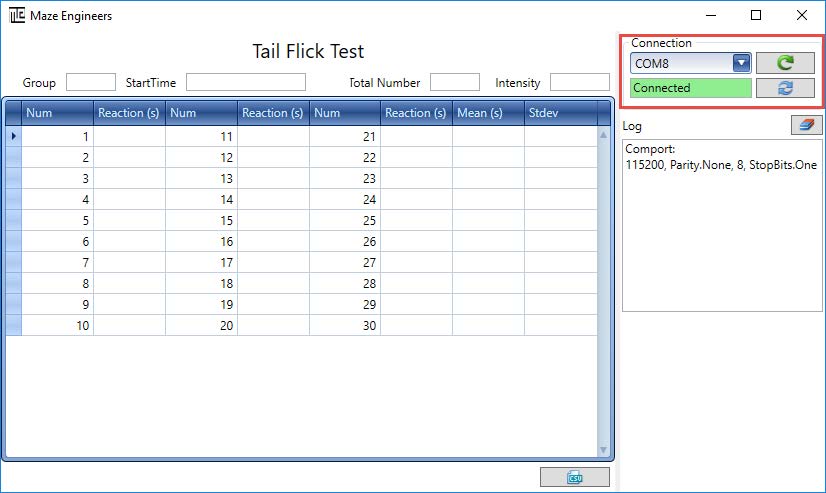
Note that the comport Reload button allows user to reload the comport list if the device is connected to computer after the software has been started.
Step 3: On the device screen, browse to the group data to upload and then press Print button on the screen
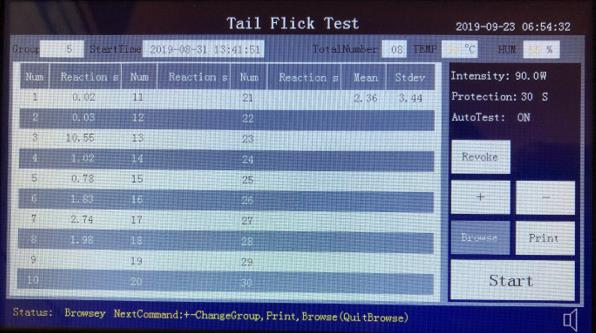
The data will be uploaded to the software screen:

Step 4: Export data to CSV file
Click button on the software screen, a file chooser appears for user to save the data with CSV data format. The default folder is C:appTailFlickTestbinuser_data.
Tail Flick Test User Manual
-
Key Components
1.1 Touch Screen
The screen is capacitive touch screen, able to achieve 99% accuracy, with a response speed of less than 3ms, smooth user experience, to meet user’s operating habits of touch screen products
The screen has the advantages of clear display, true color and high contrast. The interface design has a strong sense of hierarchy, reasonable layout and simple operation.
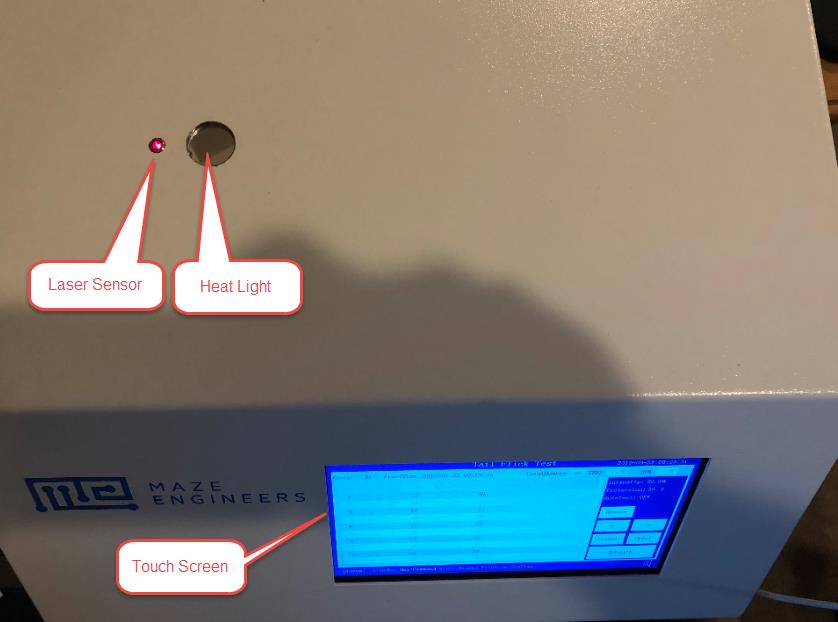
1.2 Laser Sensor
A laser sensor is used as a reaction detection of the animal’s tail moving away from the light source, and the detection time is less than 0.01S.
1.3 Light Power
The light power can be set to a range of 20w-100w with a step of adjustment 0.5w and with precise control of the illumination power through pulse width modulation.
A high-grade filter lens is used to partially absorb visible light while maximizing heat radiation. This is to achieve good experimental results and reduce the visual interference of glare to the experimenter.
1.4 Animal Refrainers
A mouse refrainer and a rat refrainer are provided. A video is included to show how to use the animal refrainer.
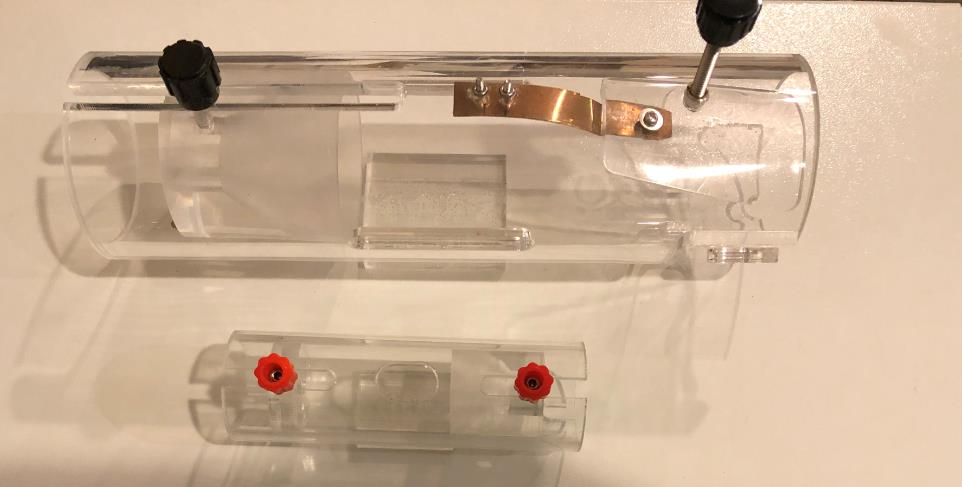
1.5 Other Accessories
- USB cable
- Foot switch
- Printer: you don’t need print if you choose to use software for data upload
- Printer power adapter and cable
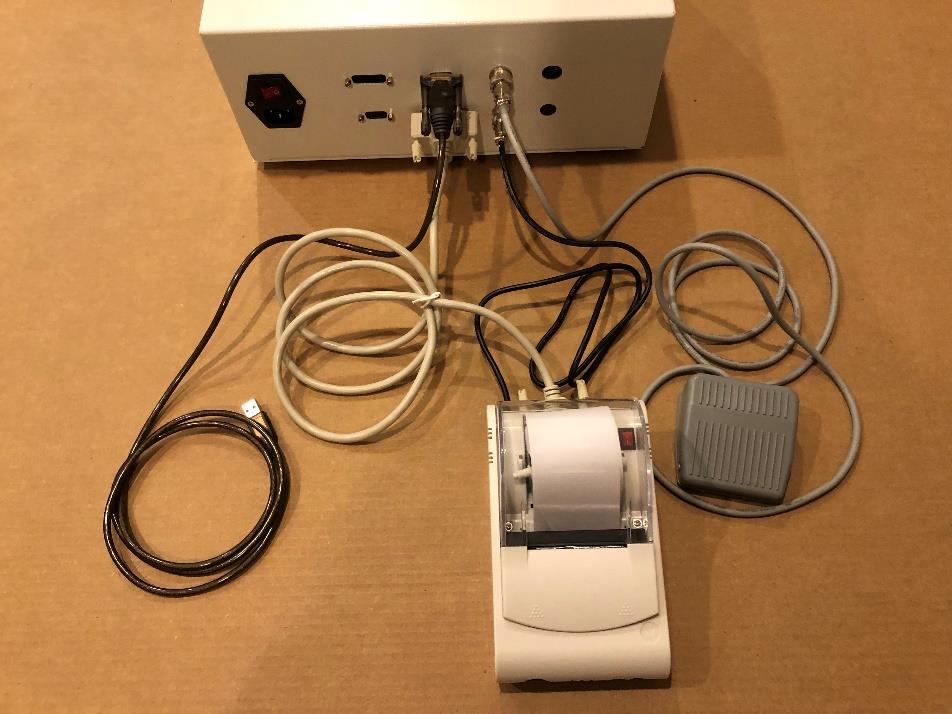
2. Connections

-
Experiment Steps
3.1 Main Screen
Turn on power, the main screen appears as shown below:

Delete data Press button will delete all experiment data and experiment group is reset to 1.
Start: Press button will enter experiment screen
3.2 Experiment Screen
When the experiment screen first appears, it shows last experiment data by default.
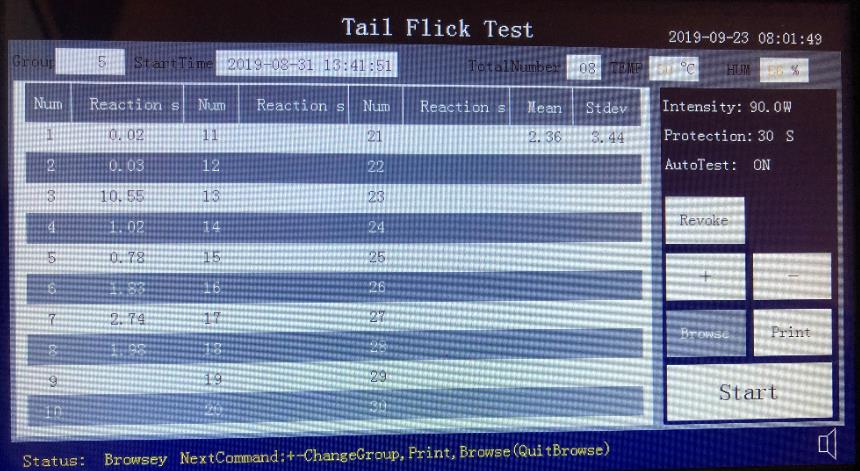
3.3. Run Experiment
Press start button on the experiment screen to start the experiment
- The experiment group increments by 1
- The Start button label changes to Stop
Put animal tail on top of the light and let the tail on the laser sensor
Press foot switch to open the heat light. This automatically starts time counting
When the animal feels pain and flick its tail,
- The sensor detects the tail flick and stop time counting
- The reaction time is recorded on screen
Repeat the experiment according to your protocol
Press Stop to finish the experiment (of this group)
3.4 Auto or Manual Time Counting
If AutoTest is on (in the auto mode), the time counting stops by the laser sensor
If AutoTest is off (in the manual mode), the time counting stops by pressing foot switch
Either case, foot switch is required to start the heat light
3.5 Browse Experiment Result
After the experiment, press Browse to navigate the experiment data, Use + and – to go to next or previous group. The device can save up to 200 groups of data.
3.6 Print Experiment Result
After the experiment, press Print button to print the group data to the printer.
If the apparatus is connected to a computer, the data can be uploaded to PC. See Tail Flick Data Upload Software Manual.pdf for more detail.
-
Maintenance
- Make sure to use the power supply in the USA
- Make sure the wires are properly connected as instructed in this manual
- Keep device cover closed while conducting experiment
Documentation
Apparatus and Equipment
For the water-immersion variant, no special apparatus is required. For this Tail Flick test variation, the water bath is to be maintained at a constant temperature throughout the testing process. On the other hand, when using a direct heat stimulus, the apparatus consists of an analgesia meter. The composition of the apparatus includes a restraining tube that comfortably limits the subject while allowing experimentation on its tail, a radiant heat source that provides focused heat stimulus, and a timer.
Training Protocol
Before beginning the experiments, the apparatus must be thoroughly cleaned. The performance can be recorded and observed using a tracking and recording system such as the Noldus EthoVision XT and ANY-Maze.
Habituation
Gently place the subject within its restraining compartment and allow it sufficient time to acclimatize to the holding chamber. Repeat the process as necessary to ensure the subject remains calm during the actual trial.
Training Trial
Place the subject in its restraining compartment and allow it 15 to 20 minutes to acclimate. To increase heat absorption, the part of the subject’s tail to be tested can be painted black. Place the subject’s tail directly under the heat source. Setting the desired intensity, start the timer and the light at the same time. Observe the subject for pain-elicited behaviors until the cut-off time (usually 20 to 35 seconds) for experiment has been reached. Repeat trials as necessary with at least 5-minute inter-trial interval.
Evaluation of carvacrol treatment in Parkinson’s disease model
Haddadi et al. tested different dosages of carvacrol and their effects on pain response in adult male Wistar rats. 6-OHDA-lesioned rats were divided into 4 groups that were treated with 25 mg/kg, 50 mg/kg, 100 mg/kg and one that served as control group along with the sham-operated group. Each subject was tested in three 15-second trials wherein different parts of the tail were subjected to the heat stimulus. In comparison to the sham group, the lesioned group showed a significant decrease in tail flick latency. However, no significant effect of carvacrol administration could be observed on the tail flick latency.
Evaluation of analgesic effects of nefopam and acetaminophen
Li et al. divided rats into 9 groups that were administered (i.p.) with 0.9% normal saline, “n” (2.5 and 5 mg/kg), “a” (42, 84 and 168 mg/kg), or combinations of “n” and “a” (1.25 N + 21 A, 2.5 N + 42 A, 5.0 N +84 A mg/kg; n=9,9 and 8) prior to the tail flick test. The Tail flick latencies were observed at five 15-minute intervals in a 30-second trial. The results showed a dose-dependent effect of the drugs on the tail flick latencies. Combination of the two drugs showed a greater antinociceptive effect than the corresponding nefopam concentration alone.
Investigation of the effect of high-fat diet on nociception
Nealon et al. used experimentally naïve adult male and female C57BL/6N mice and divided them into two diet groups. One group was maintained on a high-fat, energy-dense, while the other group was maintained on standard chow for 15-weeks before the testing and drug administration. The subjects were treated with 0 (saline), 1, 3, 10, and 30 mg/kg “m”and tested for 10 seconds in the tail flick test. A dose-dependent increase in tail withdrawal latencies was observed. A difference in the magnitude of responses was observed between the two sexes, with females on either diet showing less sensitivity to effects of “m”.
Data Analysis
The duration to withdraw tail when subjected to a radiant heat stimulus is measured in the Tail Flick test. The withdrawal latencies can be measured for different parts of the tail. During the observation, it is important to ensure that observed behavior is a reflex behavior and not a voluntary one. In case of an ambiguous behavior is observed, repeat the experiment and record the correct withdrawal latency.
Strengths & Limitations
Strength
The Tail Flick test evaluates thermal nociceptive responses of the subject. In comparison with other tests, such as the Hot Plate test and the Hargreaves test, the Tail Flick neither subjects the animal to a heated open-field nor focuses the stimulus on its plantar surface. The withdrawal latencies can be observed by directing the heat stimulus to different parts of the subject’s tail. The Tail Flick test is simple and easy to perform and comes in two variations to suit the budget of the investigation.
Limitations
In spinally transacted subjects, the tail flick response may be a spinal reflex rather than pain response (Irwin et al., 1951). Thus, consideration of the subject’s motor function (Chapman et al., 1985) is vital in achieving accurate results. The observer should be able to differentiate voluntary movement from pain reflex behaviors. Since Tail Flick test requires restraining, it is essential that the subjects are well accustomed to that process. Restraining may also cause anxiety-related behaviors. The cut-off time should not exceed 30 to 35 seconds to avoid unnecessary harm to the subject. It is important to minimize any external stimulus in the test arena to reduce their impact on the subject’s performance. Handling and consistency of the surgical process can also potentially influence tail withdrawal responses. The tail flick test may not be successful in distinguishing between opioid agonists and mixed agonist-antagonists. However, this can be overcome by using a cold-water Tail Flick test (Pizziketti et al., 1985).
Summary and Key Points
- Tail Flick test was first described by D’Amour and Smith in the year 1941.
- Tail Flick test is similar in concept to the Hargreaves test. The heat stimulus is directed on the part of the subject’s tail rather than the plantar surface.
- Tail Flick test requires restraining of the subject.
- Tail Flick test can be performed either using an analgesic meter or using a water bath.
- Painting the portion of the tail, to be tested, black allows greater absorption of the heat,
- Spinally transacted subjects may show spinal reflex behavior rather than that induced by pain.
- Subject’s motor functionality can also impact withdrawal responses.
References
Chapman CR, Casey KL, Dubner R, Foley KM, Gracely RH, Reading AE (1985). Pain measurement: an overview. Pain. 22(1):1-31.
D’Amour F. E., Smith D. L. (1941). A method for determining loss of pain sensation. J. Pharmacol. Exp. Ther. 72, 74–79.
Deuis JR, Dvorakova LS, Vetter I (2017). Methods Used to Evaluate Pain Behaviors in Rodents. Front Mol Neurosci. 10:284. doi: 10.3389/fnmol.2017.00284
Haddadi H, Rajaei Z, Alaei H, Shahidani S (2018). Chronic treatment with carvacrol improves passive avoidance memory in a rat model of Parkinson’s disease. Arq Neuropsiquiatr. 76(2):71-77. doi: 10.1590/0004-282X20170193.
Irwin S, Houde R.W, Bennett D.R, Hendershot L.C, Seevers M.H (1951). The effects of “m”e and “m”on some reflex responses of spinal animals to nociceptive stimulation. J Pharmacol Exp Ther. 101(2):132-43.
Li Q, Zhuang Q, Gu Y, Dai C, Gao X, Wang X, Wen H, Li X, Zhang Y (2018). Enhanced analgesic effects of “n” in combination with “a” in rodents. Biomed Rep. 2018 Feb;8(2):176-183. doi: 10.3892/br.2017.1032.
Nealon CM, Patel C, Worley BL, Henderson-Redmond AN, Morgan DJ, Czyzyk TA (2018). Alterations in nociception and “m” antinociception in mice fed a high-fat diet. Brain Res Bull. 138:64-72. doi: 10.1016/j.brainresbull.2017.06.019.
Pizziketti RJ, Pressman NS, Geller EB, Cowan A, Adler MW (December 1985). “Rat cold water tail-flick: a novel analgesic test that distinguishes “o” agonists from mixed agonist-antagonists“. Eur. J. Pharmacol. 119 (1–2): 23–9. doi:10.1016/0014-2999(85)90317-6.

